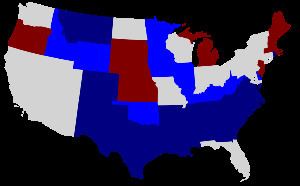November 2, 1948
(and other dates for special elections) 1950 → 23 9 9 9 Start date November 2, 1948 | 45 51 54 42 12,750,608 9,662,053 | |
 | ||
Winner Scott W Lucas | ||
The United States Senate elections of 1948 (and special elections in 1948 and 1949) were elections which coincided with the election of Democratic President Harry S. Truman for a full term. Truman had campaigned against an "obstructionist" Congress that had blocked many of his initiatives, and in addition the U.S. economy recovered from the postwar recession of 1946–47 by election day. Thus Truman was rewarded with a Democratic gain of nine seats in the Senate, enough to give them control of the chamber.
Contents
Gains and losses
In addition to gaining an open seat in Oklahoma, the Democrats defeated the following eight Republican incumbents:
Special elections during the 80th Congress
In these special elections, the winner was seated during 1948 or before January 3, 1949; ordered by election date.
Elections leading to the next Congress
In these general elections, the winners were elected for the term beginning January 3, 1949; ordered by state.
All of the elections involved the Class 2 seats.
Elections during the 81st Congress
In this special election, the winner was seated after January 3, 1949.
Montana
The Montana election took place on November 2, 1948. Incumbent United States Senator James E. Murray, who was first elected to the Senate in a special election in 1934 and was re-elected in 1936 and 1942, ran for re-election. After winning the Democratic primary, he faced Tom J. Davis, an attorney and the Republican nominee, in the general election. Following a narrow re-election in 1936, Murray significantly expanded his margin of victory and comfortably won re-election over Davis, winning his fourth term and his third full term in the Senate.
